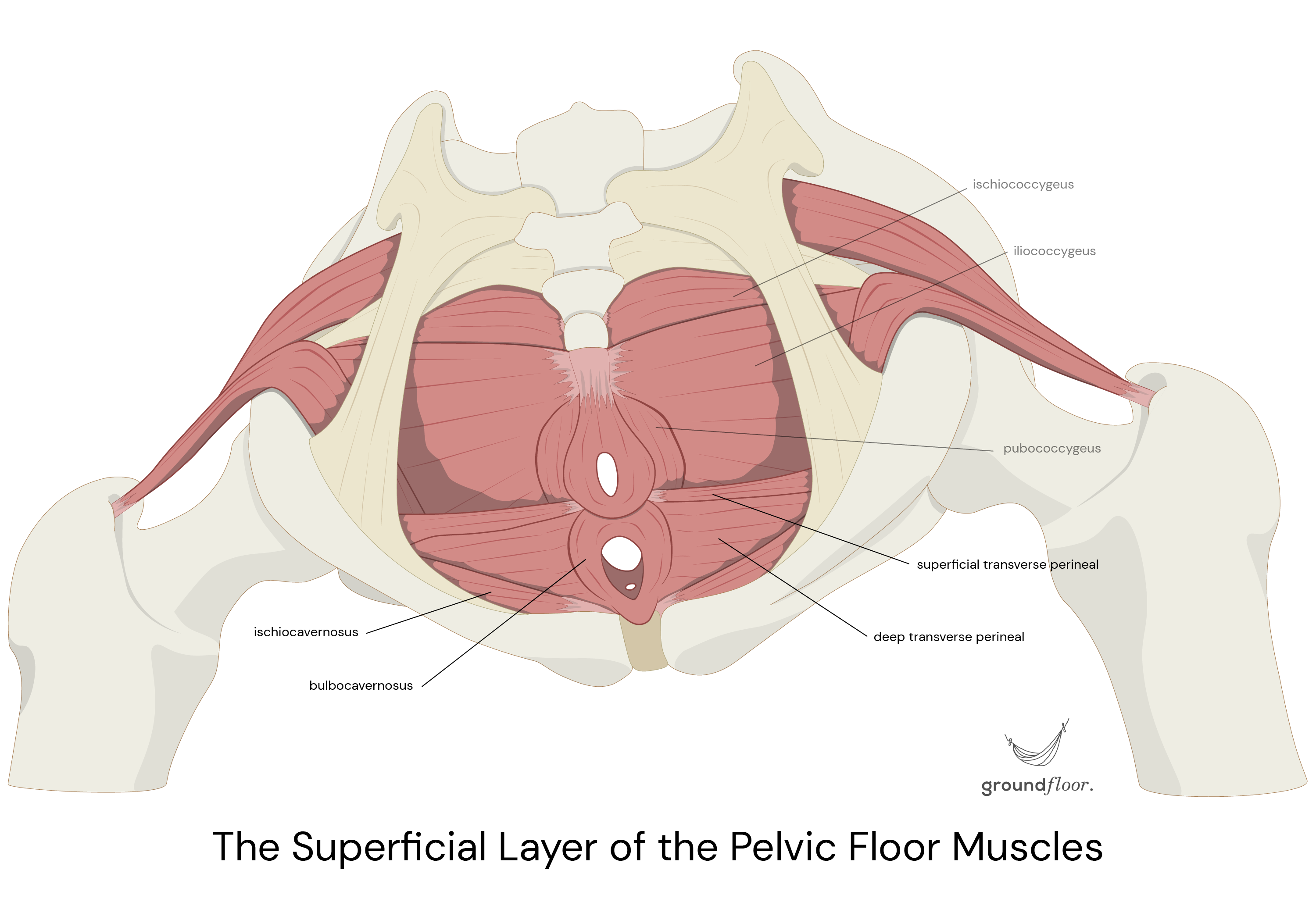
Experiencing pain during intercourse? Struggling with sensations or achieving orgasm? Contrary to common beliefs, many sexual dysfunctions are not psychogenic or hormonal in nature. Instead, they often stem from pelvic floor issues. This article will uncover strategies to improve your pelvic health while elevating your sexual life to unprecedented levels.
To start, we will explore the anatomy of the clitoris, its relationship with the pelvic floor, and their roles in the context of sexual activities. Then, we will explore prevalent dysfunctions and conditions that contribute to these challenges and provide insights into effective approaches for resolution. Finally, we will delve into the intricate interplay of physical, mental, and emotional factors within the multifaceted realm of sexuality.
Table of contents
- The anatomy of the clitoris
- The clitoris during sex
- The importance of muscular tone for sensations during sex
- The consequences of a hypertonic pelvic floor during intercourse
- How to take care of your pelvic floor to promote sexual health
- Psycho-emotional factors in the context of dyspareunia
- Other causes that can interfere with your enjoyment of sexual activities
- Likely a much-needed reminder
- Don't let pelvic health issues interfere with your sex life anymore
The anatomy of the clitoris
The clitoris is the only organ with the sole (and important) purpose of bringing pleasure to women. It contains between 8000 and 10000 sensitive receptors, which is twice the amount found in a penis. These two organs have many similarities in terms of structure and function, as both the clitoris in females and the penis in males originate from the same type of tissue during fetal development.
The clitoris is located at the top of the vulva, right above the urethral opening and tucked beneath the pubic bone. Many are only familiar with its external aspect consisting of the glans (also known as the head), which is about the size of a pea or even smaller. However, in its entirety, the clitoris measures 7 to 13 cm (3 to 5 inches), reaching the size of an average erect penis!
The internal part is divided into two portions, forming a wishbone shape. The vestibular bulbs surround the entry to the vagina, known as the introitus. The crura extend along the pubic bone and are composed of erectile tissue called corpus cavernosum.

The clitoris during sex
During female arousal, blood flow increases in the clitoral area, leading to engorgement of the sexual tissues and causing the glans to erect. This process is comparable to what occurs in a penis. However, it is less visible due to size differences and the frequent presence of a hood covering the glans (though not always, as every vulva is unique!).
Both the external and internal portions of the clitoris are sensitive and susceptible to being stimulated. Contrary to common belief, the clitoris is the reason behind sexual feelings within the vagina during penetration (and during the stimulation of the mysterious G-Spot). Unfortunately, many women struggle to enjoy penetrative sex. They often describe a lack of sensitivity, an inability to reach orgasm or even pain. Regardless of the scenario, the pelvic floor is often at cause as it plays a pivotal role in achieving satisfying and pleasurable sexual experiences. In this regard, sexual dysfunctions often stem from muscular tone issues.
The importance of muscular tone for sensations during sex
 The superficial muscles of the pelvic floor are highly involved in the process that elicits sensations during sexual activity. They have a clear anatomical connection with the clitoris, particularly the ischiocavernosus muscle (which covers the clitoral crura) and the bulbocavernosus (which encircles the vestibular bulbs). Their state greatly influences the quality of sexual experiences by participating in the engorgement of erectile tissues. The heightened blood flow to the genital area makes it more responsive to touch and stimulation.
The superficial muscles of the pelvic floor are highly involved in the process that elicits sensations during sexual activity. They have a clear anatomical connection with the clitoris, particularly the ischiocavernosus muscle (which covers the clitoral crura) and the bulbocavernosus (which encircles the vestibular bulbs). Their state greatly influences the quality of sexual experiences by participating in the engorgement of erectile tissues. The heightened blood flow to the genital area makes it more responsive to touch and stimulation.

The tone of the bulbocavernosus muscle is responsible for tightening the base of the vagina and creating compression during penetration. This effect is further amplified by the swelling of engorged erectile tissues during arousal, which further narrows the vaginal introitus. It maximises contact and gentle friction within the vagina, which stimulates the clitoris and enhances sexual sensations for both partners (in the context of heterosexual intercourse). This results in a potent erection of both the clitoris and the penis, ultimately contributing to increased pleasure and the potential achievement of orgasm—sometimes even multiple orgasms.
Besides, a well-toned pelvic floor benefits from optimal blood flow, which is a crucial factor in achieving a satisfying clitoral erection and facilitating orgasm. The female orgasm is triggered by a wave of involuntary pelvic floor contractions in response to sexual stimulation. Thus, good muscle contractility not only amplifies sensations but also enhances the ease, intensity, and duration of orgasms. Overall, optimal tone significantly elevates the entire sexual experience.
Regrettably, for women with a weak pelvic floor with decreased tone, the intricate process leading to pleasurable sensations cannot unfold as intended, resulting in a lack of sensations during intercourse.
The consequences of a hypertonic pelvic floor during intercourse
While a lack of tone can diminish sensations during intercourse, an overly tense pelvic floor, referred to as hypertonic, won't equate to more pleasure. In fact, it can be the underlying cause of both reduced sensitivity and pain.
The paradox of these contrasting outcomes arises from the limited mobility of a hypertonic pelvic floor, which hinders both optimal muscle relaxation and contraction. Whether the muscles are 'stuck' in short-range or mid-range positions dictates the resulting symptoms.
In cases where the muscles are in a short-range position (excessively drawn inward), pain during sex, known as dyspareunia, is likely to occur. The restricted mobility prevents the muscles from relaxing sufficiently to "open up" for smooth penetration, causing them to stretch beyond their threshold. The excessive friction against the vaginal walls also contributes to the pain experienced during intercourse. If you find yourself in this situation, don't dismiss the use of lubricant, as it can make a significant difference.
A specific type of pain called vulvodynia, characterised by chronic and unexplained vulvar pain or discomfort can also result from overly tense pelvic floor muscles. It can be incredibly distressing for women experiencing it. While the exact cause of vulvodynia is not fully understood, several potential factors may contribute to its development, with a predominant one being a hypertonic pelvic floor.
Women with an excessively tight pelvic floor can also be affected by vaginismus, the cause of deeply distressing sexual experiences. It is a condition where the pelvic floor muscles have reflex and involuntary contractions, closing the vaginal entry upon attempted penetration. This goes beyond just pain, rendering penetration nearly impossible for many women (apareunia). This condition is complex, involving both physical and psychological factors such as traumatic experiences, sexual abuse, and negative beliefs. Addressing the root causes is crucial, often requiring the assistance of a psychotherapist skilled in tackling such issues in combination with a pelvic floor relaxation exercises program.
It is important to note that dyspareunia, vulvodynia and vaginismus don't initially stem from a lack of desire but can certainly lead to it. Uncomfortable experiences may erode desire and even instil a fear of intimacy. What was at first a simple biomechanical issue like hypertonicity can end up setting off a vicious cycle of sexual dysfunctions on both physical and psychological levels.
Conversely, a hypertonic pelvic floor in a mid-range position (tense but not pulled in too tightly) may facilitate painless penetration but can lead to decreased sensitivity during intercourse. The limited mobility induced by muscular tension results in an inability to contract properly. Consequently, the bulbocavernosus muscle encircling the vaginal introitus (entry) cannot effectively tighten during penetrative intercourse. The vaginal opening remains relatively "wide", hindering the compression and gentle friction that stimulate the clitoris and trigger pleasurable sensations.
It's worth noting that some women unfortunate enough to experience both issues might encounter minimal sensitivity during intercourse along with localised pain in specific positions. Regrettably, this combination is quite common.
Lastly, if you need another reason to understand the importance of an optimal pelvic floor tone, consider that the incapacity to release tension can impede the ability to reach orgasm (anorgasmia). Physiologically, a certain level of muscular relaxation is required before the wave of contractions generating intense pleasure and constituting an orgasm can occur.
How to take care of your pelvic floor to promote sexual health
You can considerably enhance your overall sexual experience by increasing pleasurable sensations and relieving discomfort and pain through targeted exercises and practical advice. You might be surprised by the significant progress that can be achieved from the comfort of your own home.
After your pelvic health check-up, you can gain access to a tailored program designed to meet your specific needs. This program will combine exercises, educational content, and tracking features to encourage healthy habits for your pelvic health.
Moreover, your detailed pelvic health report will help you better understand the overall condition of your pelvic floor, which can only be empowering. It will also provide guidance on whether it is suitable to consult a doctor for additional assistance. This could involve hormone replacement therapy (HRT), systemic or topical estrogen therapy, etc. Additionally, guidance on seeking medical advice to rule out suspicions of infection or sexually transmitted diseases (STDs) will also be available.
Psycho-emotional factors in the context of dyspareunia
The basics are sometimes worth reiterating. Consent, feeling safe, and being comfortable are non-negotiable prerequisites for a healthy sexual experience. Before delving into biomechanical dysfunctions and focusing on relaxing your pelvic floor, it's crucial to ensure that you're in an environment that allows you to be at ease.
Indeed, when it comes to discussing sexuality, it's crucial to recognise the vital role of psycho-emotional factors, as the mind and body are intricately connected. Effectively addressing sexual dysfunctions requires a comprehensive range of therapeutic tools that encompass more than just physical and structural solutions.
An essential foundation for a healthy sexual life is cultivating a strong connection with yourself, particularly with your intimate parts that may have experienced past traumas, neglect, disregard or shame. These negative encounters can lead to a disassociation with your body. Through the pelvic floor exercises in your program, you have the opportunity to focus on reconnecting, increasing awareness, releasing tension, and finding inner peace. Additionally, these exercises provide benefits for addressing underlying biomechanical issues you may have.
If you are grappling with sexual dysfunction, you know how stressful and anxiety-inducing sexual encounters can be. In such cases, specific breathing exercises (including vagal stimulations) available in the program can help you manage and soothe the heightened reactions triggered by your nervous system's fight-or-flight response. These exercises also aid in restoring a harmonious connection with yourself, allowing you to release tension and feel more at ease during sexual encounters.
Lastly, past traumatic events like sexual abuse, negative beliefs surrounding sex, and self-image issues significantly contribute to sexual dysfunctions. Don't underestimate the importance of consulting a psychotherapist to address the underlying causes or contributing elements of your concerns that extend beyond the scope of pelvic floor therapy.
Other causes that can interfere with your enjoyment of sexual activities
Several conditions can indirectly affect your sexual well-being by contributing to pelvic floor dysfunctions. For example, this is the case with endometriosis, which is frequently associated with a hypertonic pelvic floor. Other health issues can also have detrimental impacts, including painful bladder syndrome, vaginal atrophy, clitoral atrophy, genitourinary syndrome of menopause (GSM), pelvic organ prolapse, and more.
If you're dealing with a health concern that has the potential to impact the pelvic floor, don't lose hope. First, you must be thorough with the treatment your trusted healthcare practitioner recommends. Additionally, you can target the symptoms that affect your sexual well-being specifically. For instance, in the case of endometriosis, you should follow the recommendations of a qualified gynaecologist while also addressing the excessive muscle tension in your pelvic floor using the relaxation exercises from your program.
This is why the Pelvic Health Check-up screens for an exhaustive list of conditions, providing a comprehensive view of your overall health while considering your unique circumstances. This approach ensures that all your pelvic health concerns are thoroughly addressed through customised solutions tailored to your individual needs.
Likely a much-needed reminder
If you find it challenging to enjoy "conventional" sex due to any of the factors mentioned earlier, keep in mind that sexual stimulation and arousal can originate from areas beyond your genitals. Your entire body holds potential for pleasure and can be a source of sensual enjoyment. Engaging your other senses, like sight, sound, and smell, as well as harnessing your imagination, can profoundly stimulate the regions of the brain in charge of sexual arousal, pleasure, desire and emotional responses related to sexuality.
Furthermore, it's important to remember that achieving orgasm doesn't have to be the ultimate goal of sexual activity, and there are no strict rules for experiencing pleasure. Diverse sensitivities and preferences are entirely normal. If certain activities aren't enjoyable to you, it doesn't signify an issue. Every individual is different, and each body should be embraced for its uniqueness!
Also, keep in mind that sex isn't limited to penetrative activities. While this article has predominantly focused on this aspect due to the prevalence of complaints and the role of the pelvic floor in related issues, it's essential to acknowledge that there are various ways to experience intimacy.
Don't let pelvic health issues interfere with your sex life anymore
While some individuals are conscious of their struggle with sexual dysfunctions, others may perceive experiences during sex, such as pain or a lack of sensation, as "normal" and unchangeable. After reading this article, you should now comprehend that the condition of your sex life is not fixed and can indeed be enhanced.
Take your pelvic floor check-up to initiate your journey toward a more fulfilling sexual life! Through this step, you will gain deeper insights into your pelvic health and be empowered to address any concerns using your personalised program.
Share this article with your friends and help spread the knowledge together! ↓
Share this article with your friends and help spread the knowledge together! →





Download the app to learn more about this topic and receive tailored information about your pelvic health!


Related articles

7 min read
The truth about having a tight pelvic floorA hypertonic or overactive pelvic floor (distinct from an overactive bladder) results from the buildup of excessive tension within the muscles. In this situation, the pelvic floor can also be referred to as "tight", which is often wrongly believed to be a good thing. This article will debunk this myth and shed light on the misconceptions surrounding this topic. Delving into the consequences of such a condition, we will also explore the common errors that can lead to a hypertonic pelvic floor and provide effective and practical strategies to address it.
→ Read more

3 min read
Breathing for your pelvic floor and the connection with stressWhile it is well known that stress can have a detrimental impact on your overall health, have you ever considered its effects on your pelvic floor?
This article will explore how your nervous system toggles between two modes to manage your body's functions. We will uncover what happens in your pelvic floor when this equilibrium is disrupted due to stress. We will also delve into the effectiveness of breathing exercises in stimulating your vagus nerve to regulate your nervous system and restore this balance.
→ Read more

3 min read
Anatomy and functions of the pelvic floorToo many people have limited knowledge about the pelvic floor and its purpose, often associating it solely with urine leakage or childbirth. However, the truth is that the pelvic floor encompasses much more than that.
In this article, we will simplify the complex concepts of pelvic floor anatomy, functions, and mechanisms of action. Our goal is to make it easier for you to understand and appreciate the importance of this vital structure.
→ Read more

